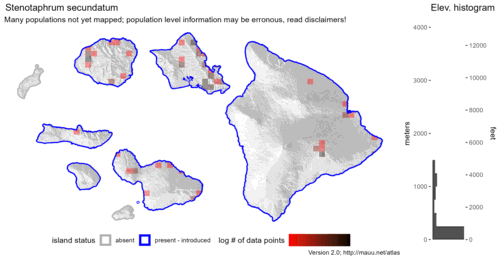Info
Subfamily: Panicoideae
Genus etymology: Stenotaphrum = "narrow canal" [Greek] refering the cavities in the inflorescence axis which house the florets
Species etymology: secundatum = "bent to one side" [Latin] refering to the inflorescence only having florets on one side
Photosynthetic type: C4 (warm season)
Nativity: naturalized - accidental
First recorded in Hawaiʻi: 1826
Map


Inflorescence


Plant





Habit


Spikelets


Stolons


Description
Plants stoloniferous. Culms 10-30 cm, decumbent, rooting at the lower nodes, branched above the base, with prominent prophylls. Sheaths sparsely pilose, constricted at the summit; ligules about 0.5 mm, membranous, ciliate; blades 3-15(18) cm long, 4-10 mm wide, thick, flat, glabrous, apices blunt. Panicles 4.5-10 cm long, less than 1 cm wide; rachises flattened, winged; branches 12-20, with 1-5 spikelets. Spikelets 3.5-5 mm, partially embedded in 1 side of the branch axes; lower glumes about 1 mm, rounded, irregularly toothed; upper glumes and lower lemmas 3-4 mm, about equal; upper lemmas papery, 5-veined, margins weakly clasping the paleas; anthers 2-2.5 mm, tan or purple. Caryopses about 2 mm, oblong to obovate. 2n = 18.
(Description source: Barkworth, M.E., Capels, K.M., Long, S. & Piep, M.B. (eds.) 2003. Flora of North America, north of Mexico. Volume 25. Magnoliophyta: Commelinidae (in part): Poaceae, Part 2. Oxford University Press, New York. 783 pp http://floranorthamerica.org/Stenotaphrum_secundatum )
Extensively creeping perennials, stolons with long internodes and short leafy branches; flowering culms ascending, 1-3 dm tall, branched, glabrous, compressed. Leaves subopposite and equitant, except in the upper part of flowering branches; sheaths 3-6 cm long, compressed, keeled, pale at base, usually membranous on margins, sparsely villous at throat and on collar, otherwise glabrous; ligule ciliate, usually less than 0.5 mm long; blades firm, stiff, 3-30 cm long, 3-10 mm wide, upper surface scabrous, lower surface glabrous, apex rounded, + split. Racemes 3-8 cm long, terminal and sometimes axillary; spikelets usually in pairs, rarely solitary or in threes, 5-6 mm long, pedicels 2-4 mm long, glabrous; first glume minute, scalelike, up to 1 mm long, second glume 5-6 mm long, 7-9-nerved; first lemma firm, 5-6 mm long, faintly 3-5-nerved; second lemma 4-5 mm long, faintly 5-7-nerved, abruptly acuminate; palea membranous, ovate, 4-5 mm long, chartaceous, glabrous, apex acute, margins inrolled. Caryopsis dark brown, ovoid, plano-convex, ca. 1.5 mm long. [2n = 18, 20, 36, 54, 72.]
(Description source: O’Connor, P.J. 1990. Poaceae, pp. 1481–1604. In: Wagner W.L., Herbst D.R. & Sohmer S.H. (eds.)., Manual of the flowering plant of Hawaiʻi. Vol. 2. University of Hawaii Press & Bishop Museum Press, Honolulu )